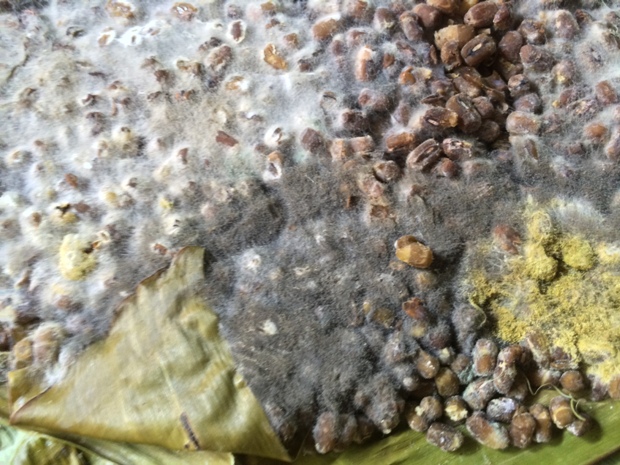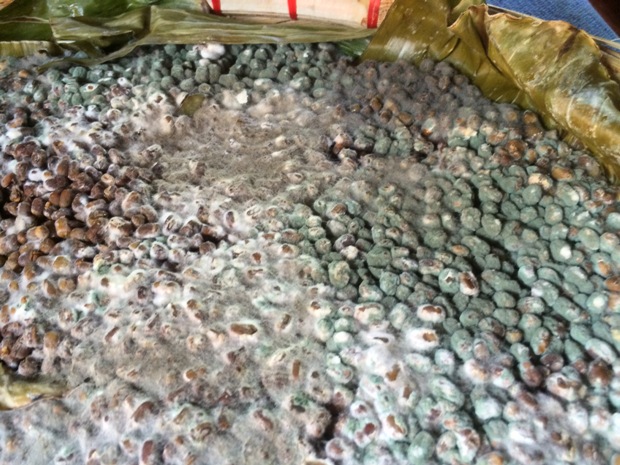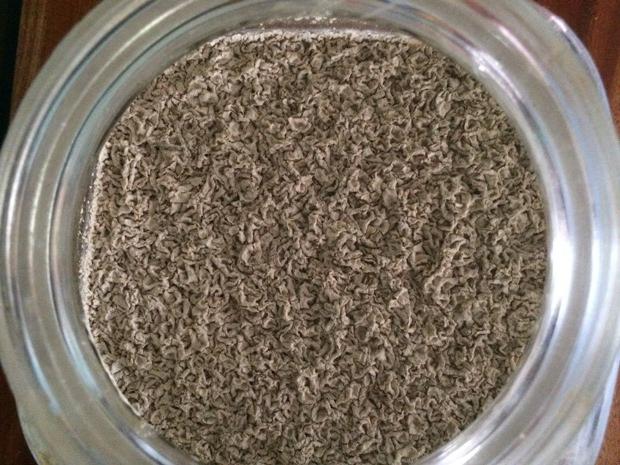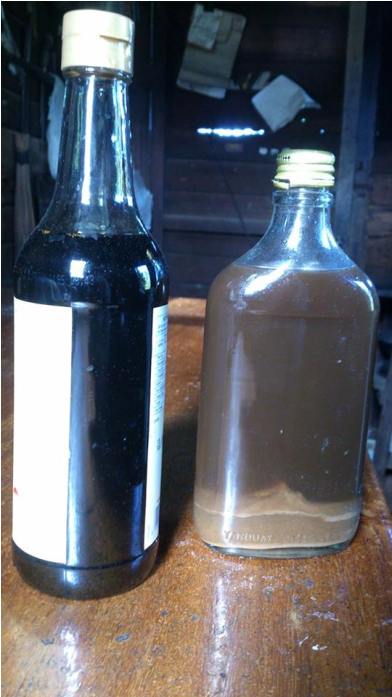DISCLAIMER: THE RESULTS OF THIS EXPERIMENT COULD BE DANGEROUS OR EVEN FATAL. I AM NOT ENCOURAGING ANYONE TO DO THE SAME INSTEAD I AM JUST SHARING MY EXPERIENCE IN THIS UNIQUE CRAFT. IF YOU WISH TO DO SOMETHING SIMILAR, DO SO AT YOUR OWN PERIL.
WARNING: EXPLICIT PHOTOS OF POSSIBLE BIO-HAZARDS. IF YOU HAVE AN IRRATIONAL FEAR OF FUZZY THINGS, CLOSE THIS TAB/WINDOW NOW!
Hello TFLers! As promised in this post, I am posting the fruit of the long culinary journey I embarked months ago which is a success! But this is in no way related to bread so I hope it does not get deleted! :)
I know many folks here are not only bread bakers; they also have many other talents/passion. Some are wine makers or beer brewers and others, occasional cheese makers. I have seen many people do those crafts at home with success but I SELDOM see someone make their OWN SOY SAUCE. I was always intrigued with the how this favorite condiment of ours is made and the idea of making my own. Now I am a "soy sauce brewer" too. Not really sure if this is technically soy sauce but more on that later.
After lots of researches, I finally knew how to make. Cook some soy beans, let them mold, dry under the sun, ferment in brine, strain and age. You read that right, let it MOLD! Soy sauce is a product of fermentation by a mold which is usually perceived as harmful organisms by those unaccustomed to it; but may delicious food items are created with the help of molds; some cheeses have molds too: more molds, more delicious! So no problem! Soy sauce brewing has also became a highly industrialized process now; made in sterile environments using pure cultures such as aspergillus oryzae so it's even safer.
Since it is impossible for me to find a pure culture and make it in a precisely controlled environment, I went the traditional route which seems even cooler! Imagine making something many think can only come from the store using simple technology and ancient know-how.
In traditional soy sauce brewing, the native microbes from the environment are what is only used; to whoever the environment is favorable takes hold and flourishes.
Also, I do not have ready access to soybeans so I thought of using other beans and making the undergo the same process and see if it will taste like soy sauce. I even entertained the idea for a baby thesis during high school back in 2008. I decided to use mung beans because it's cheap and readily available. Not really sure if it will succeed (although now there are many "non-soy soy sauces" with each "plant" giving a unique flavor), I still pushed through despite the long time the experiment needs which will be wasted if it fails. You know when you're doing something for the first time, you get excited and impatient. :D
There are many ways to prepare soy sauce which differs by country (China, Japan, Korea), by region, with how the beans are treated (whole or mashed), the source of the microbes (leaves, straw); like I said MANY! All of the steps I did has science behind it backed up by lots of research, it will be just too long if I will explain them one by one.
This is what I did:
1. I soaked mung beans overnight and steamed them for 1 hour. While hot, I spread them on a bamboo tray lined with banana leaves.

2. I covered the beans with another layer of banana leaves and wrapped the whole thing in a thick blanket to keep moisture and heat inside, then I put it on our roof under the sun for the whole day to incubate the beans. The roof is the perfect place because it is extra hot (warm) and far from the animals below.

I took it inside our house when it got dark. Oh! There is already an offensive smell. I continued to that for 6 days; by day 3 or 4, it started generating its own heat. The smell also gets stronger each day, someone doesn't need to be a bloodhound to track where it is hidden by day 3. Here are the beans after 6 days.
WARNING: EXPLICIT PHOTOS OF POSSIBLE BIO-HAZARDS. IF YOU HAVE AN IRRATIONAL FEAR OF FUZZY THINGS, CLOSE THIS TAB/WINDOW NOW!

Various wild molds of various colors have colonized the beans. The beans are now also cemented by mold mycelia. What exact mold species they are I don't know. They could be aspergillus species because it's pretty hot and humid where I live. Some of them do not look so scary like the white one but a few others look like they could kill. Green, yellow green, black, gray and various shades in between. Let us look at them up close.
Dark green mold. First time to see this kind of mold. Color is like the green crayon I used to have during kindergarten.


Black mold. Could be aspergillus niger.

Yellow green mold. Could be the aflatoxin (a potent carcinogen) producer aspergillus flavus. Actually, this is the mold that bothered me the most if I will pursue this project.

A gray mold. Could be the same mold as the black one but it's really lighter in real life. It's my first time to see this mold also.

This picture is out of focus, maybe the next picture offers a better view. It is the one surrounded by the dark green molds.

These white molds are the most normal and beautiful looking ones. They are also the ones who bound the beans most tightly. The beans just look like tempeh. They might be different molds that have not just reached the sporulation stage to reveal their differently colored spores.




3. I broke up the clumps of beans (they're pretty hot) and washed them with water to remove spores which can be bitter and excess mycelia. I was bathed by a cloud of spores during this process, I just did my best not to inhale them and just took a bath afterwards. I should have wore a mask together with gloves, thoughts of getting aspergillosis or fungus balls in the lungs ran through my mind for more than a week. :)
4. I returned them to the bamboo tray to sun dry for an entire day. Here is what they look like after sun drying.


THE SMELL! OOOOOH! I transferred them to a clean glass jar right on the roof where the sun-dried. Clay jars are the traditional fermenting vessels and I would love to use that but the one we have in the house is an antique one traditionally used for vinegar that I don't want to damage that's why I just used a large glass jar. I hope the neighbors did not thought what is this crazy guy doing picking up beans on their rooftop and covering his nose with layers of towels. :P
5. I poured 25% brine over the beans and covered the jar with a net; holes large enough to allow sunlight in but small enough to keep flies and insects out.

Trying to make the most out of the remaining sunlight for that day.

Soy sauce needs to ferment under the sun for at least 2 months to develop flavor. During this time, lots of biochemical processes which will take us to a science class if I will try to discuss take place most notably the breakdown of proteins; some folks here like biochemists, chemists, can enlighten us further.Care must be made not let it get rained, otherwise it's spoiled. It must also be stirred regularly. I forgot to stir it for a week and I got this:

Looks lovely or disgusting depending on who you are. I think, it looks like corals or a soft surface where you can jump before it swallows you. :P

During rainy days, it stays on my study table.

On sunny days, I bring it outside.

6. I fermented it for 4 months and slowly, the greenish liquid turned into a brownish amber colored liquid. It smelled really stinky but with notes of pineapple during the first 2 months so there were esters forming I suppose. After 4 months, I strained it and boiled the liquid for 20 minutes before bottling. The solids left were the miso that I kept in the same jar but insects found their way there so I had to throw it out.

Here is the finished soy sauce standing next to a bottle of commercial soy sauce. It considerably lighter due to lack of caramel color, also it is more opaque and not as refined.

At the time of bottling, it smells nothing like commercial soy sauce. Now, already aged for 4 months since bottling; it is really like soy sauce! The aroma is 80% soy sauce with 20% fish sauce notes despite being entirely of plant origin, along with a nutty note not present in commercial soy sauce. The taste is complex (possibly from the different microorganisms not limited to molds but also including yeasts and bacteria), a mix of soy and fish sauces with a pleasant nuttiness, just a tad too salty because of an imbalanced bean to brine ratio. I could have use more beans or a 20% brine, perhaps the first option is better. Other than that, very very good and I am really happy about it.
I picture this adventure using this analogy:
Commercial soy sauce is to homemade soy sauce as yeast bread is to sourdough.
I hope you enjoyed this brave or foolish journey of mine into home soy sauce brewing. Thank you and...
Happy Brewing/Baking!